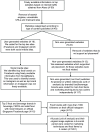Characterising the extent and nature of digital food and beverage marketing in Singapore: a descriptive study
- PMID: 39663980
- PMCID: PMC11822605
- DOI: 10.1017/S1368980024002428
Characterising the extent and nature of digital food and beverage marketing in Singapore: a descriptive study
Abstract
Objective: To characterise the nature of digital food and beverage advertising in Singapore.
Setting: Food and beverage advertisements within twenty clicks on the top twelve non-food websites and all posts on the Facebook and Instagram pages of fifteen major food companies in Singapore were sampled from 1 January to 30 June 2018.
Design: Advertised foods were classified as being core (healthier), non-core or mixed dishes (e.g. burger) using the WHO nutrient profile model and national guidelines. Marketing techniques were assessed using published coding frameworks.
Participants: NA.
Results: Advertisements (n 117) on the twelve non-food websites were largely presented as editorial content. Food companies posted twice weekly on average on social media sites (n 1261), with eatery chains posting most frequently and generating the largest amount of likes and shares. Key marketing techniques emphasised non-health attributes, for example, hedonic or convenience attributes (85 % of advertisements). Only a minority of foods and beverages advertised were core foods (non-food website: 16·2 %; social media: 13·5 %).
Conclusions: Top food and beverage companies in Singapore actively use social media as a platform for promotion with a complex array of marketing techniques. A vast majority of these posts were unhealthy highlighting an urgent need to consider regulating digital food and beverage advertising in Singapore.
Keywords: Advertisements; Asian; Food and beverage; Marketing; Online; Social media.
Conflict of interest statement
The authors declared that they have no competing interests.
Figures
References
-
- Ministry of Health (2019) Singapore National Population Health Survey 2020. https://www.hpb.gov.sg/docs/default-source/default-document-library/nphs... (accessed November 2021).
-
- G. B. D. Risk Factors Collaborators (2016) Global, regional, and national comparative risk assessment of 79 behavioural, environmental and occupational, and metabolic risks or clusters of risks, 1990–2015: a systematic analysis for the Global Burden of Disease Study 2015. Lancet 388, 1659–1724. doi: 10.1016/S0140-6736(16)31679-8. - DOI - PMC - PubMed
-
- Guidelines Review Committee, Nutrition and Food Safety (NFS) & Nutrition Guidance Expert Advisory Group (2023) Policies to Protect Children from the Harmful Impact of Food Marketing: WHO Guideline. https://www.who.int/publications/i/item/9789240075412 (accessed August 2024).
-
- World Health Organization (2022) Food Marketing Exposure and Power and their Associations with Food-Related Attitudes, Beliefs and Behaviours: A Narrative Review. https://iris.who.int/bitstream/handle/10665/351521/9789240041783-eng.pdf... (accessed August 2024).
MeSH terms
LinkOut - more resources
Full Text Sources


